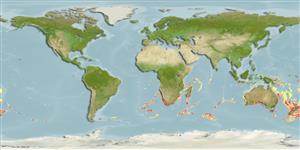Environment: milieu / climate zone / depth range / distribution range
Écologie
marin bathydémersal; profondeur 220 - 1550 m (Ref. 6548). Deep-water
Southeast Atlantic and Western Indian Ocean: around South Africa between 30° and 35°S. Southwest Pacific: Australia (including western and southern Australia) and New Zealand (Ref. 5755).
Taille / Poids / Âge
Maturity: Lm ? range ? - ? cm
Max length : 21.0 cm TL mâle / non sexé; (Ref. 6548)
Épines dorsales (Total) : 6 - 8; Rayons mous dorsaux (Total) : 29 - 31; Épines anales: 2 - 3; Rayons mous anaux: 28 - 31. Prejuveniles blackish violet in color; cones and irregular blotches on back greenish silvery (Ref. 6548).
Found on the continental slope. Benthic species (Ref. 75154).
Life cycle and mating behavior
Maturities | Reproduction | Spawnings | Egg(s) | Fecundities | Larves
Karrer, C., 1986. Oreosomatidae. p. 438-440. In M.M. Smith and P.C. Heemstra (eds.) Smiths' sea fishes. Springer-Verlag, Berlin. (Ref. 6548)
Statut dans la liste rouge de l'IUCN (Ref. 130435)
Menace pour l'homme
Harmless
Utilisations par l'homme
Outils
Articles particuliers
Télécharger en XML
Sources Internet
Estimates based on models
Preferred temperature (Ref.
123201): 2.2 - 10.9, mean 7.5 °C (based on 594 cells).
Phylogenetic diversity index (Ref.
82804): PD
50 = 1.0010 [Uniqueness, from 0.5 = low to 2.0 = high].
Bayesian length-weight: a=0.01622 (0.00733 - 0.03589), b=3.03 (2.83 - 3.23), in cm total length, based on LWR estimates for this (Sub)family-body shape (Ref.
93245).
Niveau trophique (Ref.
69278): 3.4 ±0.5 se; based on size and trophs of closest relatives
Résilience (Ref.
120179): Très faible, temps minimum de doublement de population supérieur à 14 ans (Preliminary K or Fecundity.).
Fishing Vulnerability (Ref.
59153): Low vulnerability (11 of 100).
